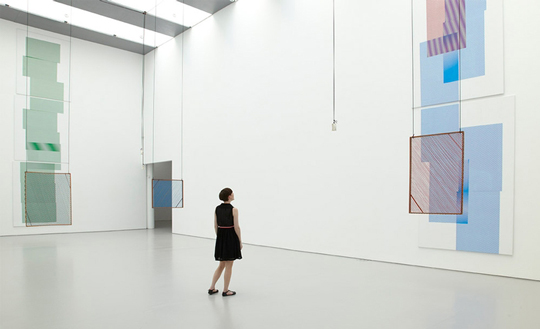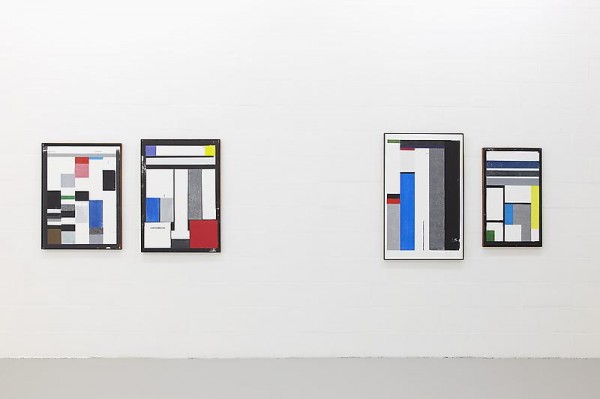Melissa Gordon
Monday, 1 September 2014



Work from her oeuvre.
“‘Material Evidence’ was Melissa Gordon’s first solo exhibition in a public space in the UK, the result of a residency hosted by Spike Island and Spike Print Studio. As well as site-specific productions, the show included work from three ongoing series – Gordon’s continuing investigations into the legacy of Modernist abstraction and the intimacies of process. The particular success of ‘Material Evidence’ was how Gordon synthesized in her site-specific work both her inter-series dialogues and her response to the eight-metre-high main gallery.
This response was Structures for Viewing (2013), a two-colour triptych and diptych. Each set of canvases comprises screen-printed blocks of halftone lines on the diagonal, and, suspended a couple of metres in front of these, wooden frames strung with nylon cords of contrasting colours, threaded on the opposing diagonal. Patterns of disturbance occurred where blocks had been overlaid, while further interference could be introduced by the visitor, either via his or her movement through the gallery, or by viewing the prints through the half-mesh of the suspended screens. To walk between screen and canvas felt disruptive.
Process – or, rather, the evidence of process – is the focus of Gordon’s ‘Material Evidence’ series, which she began in 2011. The two paintings created for this show, Material Evidence (Table)and Material Evidence (Wall) (both 2013), were based on photos of the work surfaces in Gordon’s London studio, the images blown up and cropped to highlight details then re-created on canvas. The series title recalls an earlier painting of Gordon’s, Crimeboard for an Elusive Primadonna (2005), a montage of images from an incident room. ‘Material Evidence’ similarly depicts a presence indicating an absence, a series of traces in place of a missing referent.
The term ‘Material Evidence’ suggests proof, but also justification – a loaded term in the context of Gordon’s ‘Blow Up’ series (2011), her study of Western Modernism’s legacy of patriarchal abstraction. Gordon is on the look-out for weaknesses in the male line: she researches reproductions of works by canonical artists (Mondrian, Pollock and Van Doesburg), specifically, images that reproduce visible traces of deterioration in the original work. She then abstracts from these abstracts: enlarging these signs of distress, she highlights the works’ limited life span as objects in the world, simultaneously extracting from them new abstractions. The resulting black and white screen-prints suggest the inkiness and granularity of photocopies of photocopies; they speak of well-worn, over-handled images.
Similar strategies of mediation and abstraction are evident in a third line of enquiry, the series ‘The Daily News RIP’ (2013), in which Gordon engages with the structures of newspaper layouts to create scenarios for abstract composition. Taking the front pages of now-defunct newspapers, Gordon empties them of text and uses the remaining grid structures as the basis for full-colour paintings. This exercise brings to mind Kenneth Goldsmith’s Day(2003), where he transcribed all the text printed in The New York Times on 1 September 2000. The weighting of news items via the paper’s layout and grid structure was removed in Goldsmith’s act of transcription, hierarchies of significance destabilized by facile juxtapositions. In Gordon’s two diptychs, Daily Evening Star/The Washington Star (1852–1981) and Daily Evening Transcript/Boston Evening Transcript (1848–1941) (both 2013), suggestions of informational hierarchy were retained by the structures, despite their being emptied of text: her use of colour to fill in the grids suggested an encoding, rather than an elimination, of the original content.
Thematic ley lines cut across this show, paralleling the cross-hatching created in Structures for Viewing by the interactions between viewer, canvas and screen. These cross-currents were not restricted to the gallery: the field of response and counter-response extended across the nearby river, to the Arnolfini Gallery and Ian Hamilton Finlay’s exhibition there: among the hundreds of postcards on display was one bearing the text, ‘Join the Saint-Just Vigilantes and be a counter-composition.’ The accompanying image, a black abstract which brought to mind one in Gordon’s own ‘Blow Up’ series, with a note from Finlay: ‘acknowledgement to Theo van Doesburg’.” – Natasha Soobramanien, Frieze Magazine